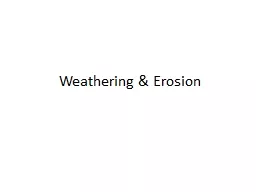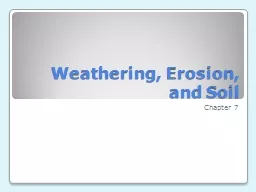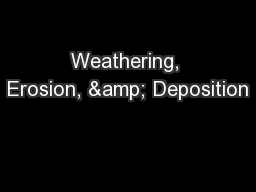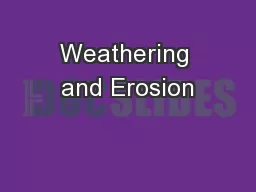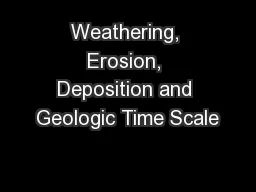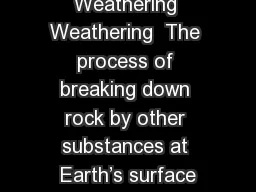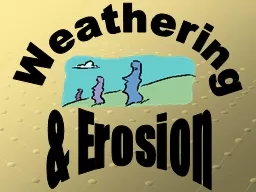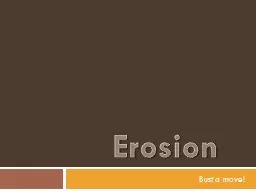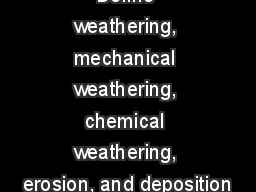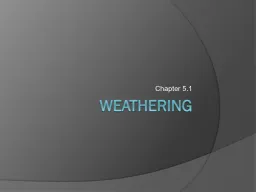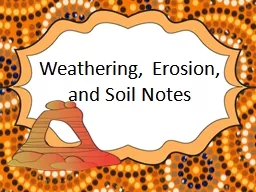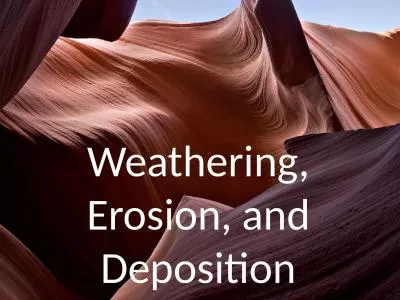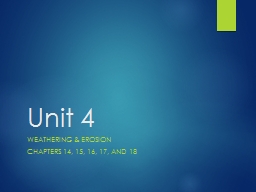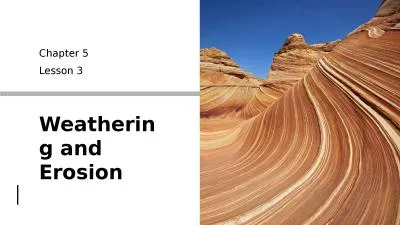PPT-Weathering & Erosion
Author : karlyn-bohler | Published Date : 2017-01-28
Earths Changing Surface Earth is a constantly changing body affected by natural forces On the Inside Plate Tectonics moving of Earths Plates driven by convection
Presentation Embed Code
Download Presentation
Download Presentation The PPT/PDF document "Weathering & Erosion" is the property of its rightful owner. Permission is granted to download and print the materials on this website for personal, non-commercial use only, and to display it on your personal computer provided you do not modify the materials and that you retain all copyright notices contained in the materials. By downloading content from our website, you accept the terms of this agreement.
Weathering & Erosion: Transcript
Earths Changing Surface Earth is a constantly changing body affected by natural forces On the Inside Plate Tectonics moving of Earths Plates driven by convection currents Earthquakes amp Volcanoes. Bust a move!. What is Erosion?. Erosion is defined as removal of rocks and soil by wind, water, ice and gravity.. Wind, water, ice and gravity are also known as the agents of erosion.. Weathering vs. Erosion . Chapter 7. Section 7.1 Weathering. Weathering is the process by which rocks on or near Earth’s surface break down and change. . Erosion is the removal and transport of weathered material from one location to another.. The . surface. features of the Earth change as a result of observable physical and chemical processes . Weathering and Erosion. This is a monument . called Cleopatra’s . Needle. It was carved in Egypt around 1450B.C. The sides are carved with hieroglyphs, the writing of ancient Egypt. It stood in the dry, hot Egyptian desert for over 3000 years. During that time, the hieroglyphs remained distinct.. formation of landforms. weathering and erosion. The process of weathering and erosion are the main forces behind landscape types. . However, they are not the only reason for a plain, plateau, or a mountain region to form. . Weathering. Weathering is the process that breaks down rock and other substances at the Earth’s surface. . Heat, cold, water, and ice all contribute to weathering.. Repeated freezing and thawing for example can crack rock apart into smaller pieces. . Erosion. The carrying weathered rock from one location to another . Mechanical Weathering. Rock is physically broken down. Smaller pieces have same composition. Chemical Weathering. Rock is chemically broken down. Weathering. is the break-up of rock due to exposure to the atmosphere.. Weathering. involves two processes that often work together to decompose or break down rocks.. Chemical and Mechanical. Weathering!. What is Erosion?. Erosion is defined as removal of rocks and soil by wind, water, ice and gravity.. Wind, water, ice and gravity are also known as the agents of erosion.. Weathering vs. Erosion . Weathering involves two processes . Predict how weathering might reshape surface features (topography). Weathering and Erosion. The top part of the lithosphere—the earth’s surface—changes as rocks are broken down to smaller pieces and carried away.. Weathering can be defined as any. chemical or mechanical process by which rocks exposed to weather undergo changes in character or are broken down into smaller pieces. .. Mechanical Weathering. Mechanical Weathering. Weathering. Notes. Weathering. - The surface processes that break down rock into small pieces called sediment. . Two Types of Weathering. MECHANICAL WEATHERING. – . . Physical. processes that break rock into fragments with the . Weathering. : the breaking up of rock into smaller pieces . Erosion. : the movement of sediment from place to place by wind, water, ice, or gravity. Deposition. : the re-depositing of sediments in a new location following erosion . Chapters 14, 15, 16, 17, and 18. SES3. Students will explore the actions of water, wind, ice, and gravity that create landforms and systems of landforms (landscapes). . a. . Describe how surface water and groundwater act as the major agents of physical and chemical weathering. . Lesson 3 . Please Do Now!!!!! . -Looking at this picture what do we think caused this boulder to break apart???. -Please write down your thoughts. . -If you get the correct answer Miss. Swisher will give you a dollar. .
Download Document
Here is the link to download the presentation.
"Weathering & Erosion"The content belongs to its owner. You may download and print it for personal use, without modification, and keep all copyright notices. By downloading, you agree to these terms.
Related Documents

